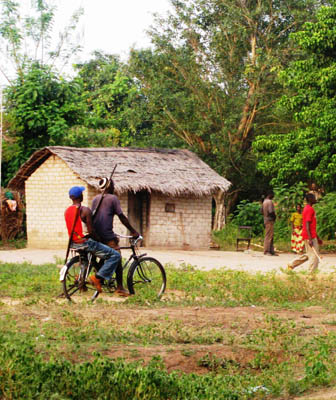MBOKI, Central African Republic – “The tongo-tongo are coming,” yelled a man on a bike on March 11, 2010, with a manufactured gun dangling from his right shoulder. His cries of alarm, using the local word for the Lord’s Resistance Army, set in motion a series of events I had often heard described by victims of LRA attacks, but never before witnessed personally.

Initially, those who heard the warning cries were hesitant to move, as they tried to confirm the information. Soon, the feeling turned to worry, escalating to sheer panic. People were running, there was screaming. And then, unlike most LRA-affected areas I have been to, armed civilians appeared. Men wielding machetes, knives, and locally manufactured rifles showed up and began walking in the direction the LRA was supposedly coming from.
As it turned out, it was just a rumour. But the incident illustrated clearly the stress and fear people living under the threat of LRA attacks in Central African Republic, Congo and Sudan experience daily. The people of Mboki have every reason to worry about LRA violence. An attack on July 24, 2009 left five dead and many more injured. But in an extraordinary feat of bravery, the people of Mboki armed with bows and arrows, stood up to the LRA attackers equipped with firearms. Three rebels were killed in the ensuing clash, and two died later in the bush due to injuries sustained during the attack.
The LRA attack was repulsed by the town’s self-defence force, a mixed group of about 200 people, comprised of Chadian traders, Mbororo cattle herders, Sudanese refugees and the local Zande population. Led by a former Chadian soldier-turned- professor of philosophy, the self-defence groups protect their neighbourhoods in daily and nightly shifts. Despite their bravery, these groups, armed mostly with bows and arrows, are unevenly matched to LRA attackers who possess machine guns and rocket-propelled grenades.
Professional soldiers capable of standing up to a well-organized and armed LRA force are badly needed in CAR. The national army, the FACA, are few in numbers in LRA-affected areas and lack the willingness to fight. The handful of FACA soldiers in Mboki did not intervene in the July attack, despite being based only a mile from the market that was attacked. There are, at the moment, about 50 soldiers from the Ugandan army operating in Mboki, but they are too few to protect such a large area bordered in the south by a massive forest, the Bomu Orientale, where at least one LRA group is based.
Despite the presence of thousands of Ugandan troops in CAR, LRA attacks have steadily continued for the last two years. (The first attack in CAR came on the night on March 5, 2008, where an LRA force commanded by Okot Odhiambo abducted more than 70 people in Obo.) Little information comes out of CAR due to the lack of international organizations and national media in the area. During a research trip in the Central African towns of Obo, Mboki, Zemio, Djemah, and Sam Ouandja last month, it became clear that the Lord’s Resistance Army, far from being decimated as some officials claim, continues to be a terrorizing force in the region. It is just that the outside world does not hear much about it. (A detailed Enough report is forthcoming.)
About a week after I left Mboki, on March 19, 2010, the town was attacked by the LRA. Two people were killed, one was injured, and three children were abducted.

